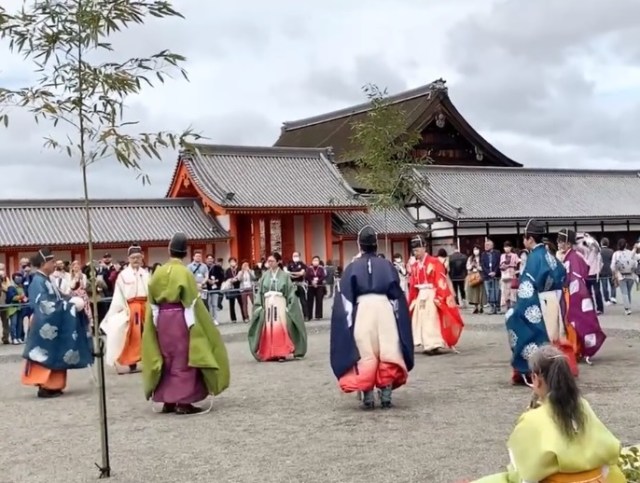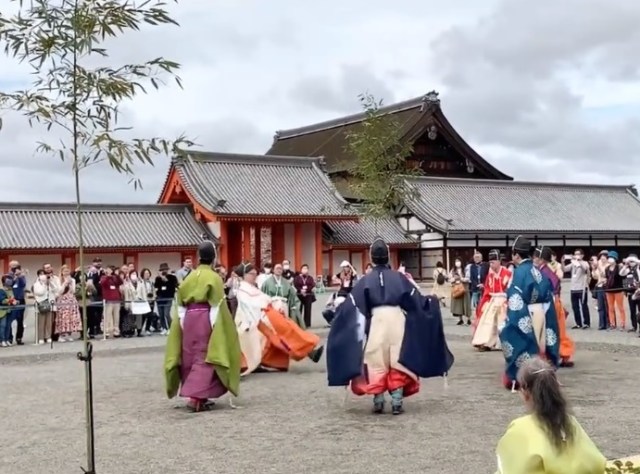
Kickball the Heian way.
Japanese Twitter user @yoshimura0303 was recently out and about in Kyoto when he stumbled across a kemari game taking place. “Kemari” comes from the Japanese words keru, meaning “kick,” and mari, meaning “ball,” so the direct translation would be “kickball.”
However, this wasn’t the same “kickball” played by energetic kids in America who kick a rubber ball around a baseball field because they don’t have bats and gloves to play with. Kemari is a game that became popular with Japanese aristocrats and members of the imperial court all the way back in the Heian period (794-1185), and the kemari game @yoshimura0303 watched wasn’t being played in any old park, but at the the Kyoto Imperial Palace.
京都御所で蹴鞠に遭遇。
— 亀屋良長 吉村良和 (@yoshimura0303) March 24, 2023
装束も動きにくいし右足しか使ってはいけないそうです。
鞠は鹿の皮。
結構激しい。 pic.twitter.com/oHi0dibr1o
The game was part of a multi-day event organized by the Imperial Household Agency introducing aspects of courtly life from the era when the imperial family still resided in Kyoto. In keeping with that historical context, the participants all dressed in formal attire of the Heian period, wearing traditional sandals, billowy hakama pants, kimono with luxuriously lengthy sleeves, and high-peaked eboshi hats.
Kemari is a cooperative game, most similar to hacky sack, with the goal being to keep the rally going for as long as possible without the ball (which is made from deerskin) hitting the ground. As you can probably guess from kemari’s name, you’re only allowed to kick the ball, not use any other part of your body. As an added piece of difficulty, you can only use your right foot, not your left, and that restriction makes proper positioning particularly important, despite the stately attire of the aristocracy not being the easiest outfit to move around in.
Reactions to @yoshimura0303’s video have included:
“So elegant!”
“It looks really hard.”
“It’s like you went back in time.”
“I wish I could have seen this in-person.”
“Want to try it myself now.”
Unfortunately for that last commenter, it’s been several hundred years since kemari was commonly played in Japan, so finding a neighborhood league isn’t exactly easy to do. On the other hand, as long as you’re not a stickler for period-authentic clothing and ball materials, putting together a game with friends shouldn’t be too hard, especially since the non-competitive nature of kemari means you don’t need a referee. Just be sure you’re not playing somewhere where a bouncing ball is going to bother other people, especially if you’re playing in manners-minded Kyoto.
Source: Twitter/@yoshimura0303 via IT Media
Images: Twitter/@yoshimura0303
● Want to hear about SoraNews24’s latest articles as soon as they’re published? Follow us on Facebook and Twitter!


 Check out the ball-handling skills of classical Japanese aristocrats with this new video
Check out the ball-handling skills of classical Japanese aristocrats with this new video Interactive online map of Kyoto lets you toggle between modern day and the 9th century
Interactive online map of Kyoto lets you toggle between modern day and the 9th century Mounted police officers in Kyoto get Heian Period outfits to match their ancestral colleagues
Mounted police officers in Kyoto get Heian Period outfits to match their ancestral colleagues Japanese comedian uses traditional Japanese court instrument to play…the McDonald’s fryer alarm?
Japanese comedian uses traditional Japanese court instrument to play…the McDonald’s fryer alarm? Kyoto hotel OMO5 Kyoto Gion offers Yojiya cosmetics Pretty Girl Room Stay for New Year’s season
Kyoto hotel OMO5 Kyoto Gion offers Yojiya cosmetics Pretty Girl Room Stay for New Year’s season Japanese ramen restaurants under pressure from new yen banknotes
Japanese ramen restaurants under pressure from new yen banknotes McDonald’s new Happy Meals offer up cute and practical Sanrio lifestyle goods
McDonald’s new Happy Meals offer up cute and practical Sanrio lifestyle goods Tokyo Tsukiji fish market site to be redeveloped with 50,000-seat stadium, hotel, shopping center
Tokyo Tsukiji fish market site to be redeveloped with 50,000-seat stadium, hotel, shopping center New private rooms on Tokaido Shinkansen change the way we travel from Tokyo to Kyoto
New private rooms on Tokaido Shinkansen change the way we travel from Tokyo to Kyoto French Fries Bread in Tokyo’s Shibuya becomes a hit on social media
French Fries Bread in Tokyo’s Shibuya becomes a hit on social media Mt. Koya planning to instate visitor’s tax to cope with huge tourist numbers
Mt. Koya planning to instate visitor’s tax to cope with huge tourist numbers Japanese company starts project to restore Nakagin Capsules to capsule hotel
Japanese company starts project to restore Nakagin Capsules to capsule hotel Beautiful Red and Blue Star luxury trains set to be Japan’s new Hokkaido travel stars
Beautiful Red and Blue Star luxury trains set to be Japan’s new Hokkaido travel stars Secret Kitchen bento serves Japanese flowers, birds, wind and moon in a box, but is it worth it?
Secret Kitchen bento serves Japanese flowers, birds, wind and moon in a box, but is it worth it? Sakura tree falls on man at Sannenzaka near Kiyomizu temple in Kyoto 【Breaking News】
Sakura tree falls on man at Sannenzaka near Kiyomizu temple in Kyoto 【Breaking News】 All-you-can-drink Starbucks and amazing views part of Tokyo’s new 170 meter-high sky lounge
All-you-can-drink Starbucks and amazing views part of Tokyo’s new 170 meter-high sky lounge More foreign tourists than ever before in history visited Japan last month
More foreign tourists than ever before in history visited Japan last month Starbucks reopens at Shibuya Scramble Crossing with new look and design concept
Starbucks reopens at Shibuya Scramble Crossing with new look and design concept Studio Ghibli releases new action figures featuring Nausicaä of the Valley of the Wind characters
Studio Ghibli releases new action figures featuring Nausicaä of the Valley of the Wind characters Studio Ghibli glasses cases let anime characters keep an eye on your spectacles
Studio Ghibli glasses cases let anime characters keep an eye on your spectacles Is the new Shinkansen Train Desk ticket worth it?
Is the new Shinkansen Train Desk ticket worth it? Beautiful Ghibli sealing wax kits let you create accessories and elegant letter decorations【Pics】
Beautiful Ghibli sealing wax kits let you create accessories and elegant letter decorations【Pics】 Studio Ghibli releases Kiki’s Delivery Service chocolate cake pouches in Japan
Studio Ghibli releases Kiki’s Delivery Service chocolate cake pouches in Japan New definition of “Japanese whiskey” goes into effect to prevent fakes from fooling overseas buyers
New definition of “Japanese whiskey” goes into effect to prevent fakes from fooling overseas buyers Our Japanese reporter visits Costco in the U.S., finds super American and very Japanese things
Our Japanese reporter visits Costco in the U.S., finds super American and very Japanese things Studio Ghibli unveils Mother’s Day gift set that captures the love in My Neighbour Totoro
Studio Ghibli unveils Mother’s Day gift set that captures the love in My Neighbour Totoro Domino’s Japan now sells…pizza ears?
Domino’s Japan now sells…pizza ears? New Japanese KitKat flavour stars Sanrio characters, including Hello Kitty
New Japanese KitKat flavour stars Sanrio characters, including Hello Kitty New Pokémon cakes let you eat your way through Pikachu and all the Eevee evolutions
New Pokémon cakes let you eat your way through Pikachu and all the Eevee evolutions Sales of Japan’s most convenient train ticket/shopping payment cards suspended indefinitely
Sales of Japan’s most convenient train ticket/shopping payment cards suspended indefinitely Sold-out Studio Ghibli desktop humidifiers are back so Totoro can help you through the dry season
Sold-out Studio Ghibli desktop humidifiers are back so Totoro can help you through the dry season Japanese government to make first change to romanization spelling rules since the 1950s
Japanese government to make first change to romanization spelling rules since the 1950s Ghibli founders Toshio Suzuki and Hayao Miyazaki contribute to Japanese whisky Totoro label design
Ghibli founders Toshio Suzuki and Hayao Miyazaki contribute to Japanese whisky Totoro label design Doraemon found buried at sea as scene from 1993 anime becomes real life【Photos】
Doraemon found buried at sea as scene from 1993 anime becomes real life【Photos】 Tokyo’s most famous Starbucks is closed
Tokyo’s most famous Starbucks is closed One Piece characters’ nationalities revealed, but fans have mixed opinions
One Piece characters’ nationalities revealed, but fans have mixed opinions We asked a Uniqlo employee what four things we should buy and their suggestions didn’t disappoint
We asked a Uniqlo employee what four things we should buy and their suggestions didn’t disappoint Princesses, fruits, and blacksmiths: Study reveals the 30 most unusual family names in Japan
Princesses, fruits, and blacksmiths: Study reveals the 30 most unusual family names in Japan Pokémon Centers around Japan celebrate the opening of Kyoto branch with commemorative goods
Pokémon Centers around Japan celebrate the opening of Kyoto branch with commemorative goods Comfy kimono hakama roomwear steps into the modern era with stylish new Reiwa Edition【Photos】
Comfy kimono hakama roomwear steps into the modern era with stylish new Reiwa Edition【Photos】 This woolly Yoshi Amiibo will make magic happen on-screen, be your bedtime buddy afterwards
This woolly Yoshi Amiibo will make magic happen on-screen, be your bedtime buddy afterwards Dress like an aristocrat from the Nara period at new costume rental shop in Nara【Photos】
Dress like an aristocrat from the Nara period at new costume rental shop in Nara【Photos】 J-Pop singer to perform song written and composed by the emperor and empress at upcoming ceremony
J-Pop singer to perform song written and composed by the emperor and empress at upcoming ceremony Japanese confectionery store Toraya serves up a surprising meal in Paris
Japanese confectionery store Toraya serves up a surprising meal in Paris Is spending 248,380 yen (US$1,840) on an anime boy doll a wise choice? Our fangirl finds out!
Is spending 248,380 yen (US$1,840) on an anime boy doll a wise choice? Our fangirl finds out! Legendary DJ Krush performs with traditional Japanese musicians to create music for your dreams
Legendary DJ Krush performs with traditional Japanese musicians to create music for your dreams Kyoto massage parlor would like to offer you a head rub on a self-driving tatami reed floor【Vid】
Kyoto massage parlor would like to offer you a head rub on a self-driving tatami reed floor【Vid】 Pokémon GO player claims his in-game snapshot shows Japan’s new emperor and Pikachu together
Pokémon GO player claims his in-game snapshot shows Japan’s new emperor and Pikachu together Japanese fashion label’s samurai chino pants are on the move again with new colors
Japanese fashion label’s samurai chino pants are on the move again with new colors Lunch at Kyoto Gyoen National Garden, delivered in an Imperial carriage
Lunch at Kyoto Gyoen National Garden, delivered in an Imperial carriage This table tennis player shows that “nothing is impossible” 【Video】
This table tennis player shows that “nothing is impossible” 【Video】 Crowd-funded hakama roomwear doubled its funding goal, is now available to everyone
Crowd-funded hakama roomwear doubled its funding goal, is now available to everyone Kyoto Station is a bad place to be in a snowstorm, videos show
Kyoto Station is a bad place to be in a snowstorm, videos show
Leave a Reply